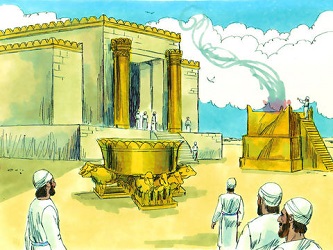
Since we are in the middle of a long story of its preparation and construction, I thought it might be good to consider the most central feature of Israel’s religious life—the temple.
Location: Many believe that the Dome of the Rock currently occupies the former site of Israel’s temple so the big question is not so much the location of the temple, but the location of the Holy of Holies. Is it likely that the exposed rock under The Dome was once the floor for the Holy of Holies?
I have a book from the Biblical Archaeology Society that examines the Temple Mount and the rock under The Dome in amazing detail. They conclude that the Ark of the Covenant was placed on a curious rectangular depression found on the rock (the depression happens to be the same size as the Ark). If they are correct (and their argument is convincing to me), then that exposed rock under the dome is Mount Moriah, the place where Abraham was stopped from sacrificing his promised son. Moriah could be associated with a theologically significant Hebrew verb meaning “to see” or “to provide.” If these conclusions are true, then this location is unlike any other in the world. It is a place where, again and again, God provided the lamb and reconciled Himself to His people.
Mount Moriah was later the site of Araunah’s threshing floor and the place where David’s sacrifice was accepted by the LORD as “fire fell from heaven” (1 Chronicles 21:26). It is no surprise that this historically and theologically significant location became the logical site for the temple and the location for the Holy of Holies (1 Chronicles 22:1).
Construction: David was not allowed to build the temple (he was a man of blood) but was told that his son, Solomon (who was a man of peace), would build the structure. So David “made extensive preparations [for building the temple] before his death” (1 Chronicles 22:5). Solomon added to his father’s provision, secured supply chains through diplomatic treaties and went to work. It took seven years to build and was one of the most magnificent structures in the ancient world. Just imagine what it would have been like to travel to Jerusalem in that day. As you look up (Jerusalem was a high point in the mountains) you see the white limestone, bronze and gold absolutely gleaming in the sunshine. It must have been breathtaking.
Design: Concentric circles are one symbolic way to think of the temple’s design (it was not really set up in circles; this just communicates the idea). The center circle is the Holy of Holies and only one person on one day each year was allowed to enter this space. Each circle radiating out from the Holy of Holies represents greater distance from the Holy One; the further out you get the more populated the circles become. While the High Priest was the only one allowed to enter the inner-most circle of the Holy of Holies, anyone in the world was allowed to stand in the outermost circle which was called the Court of Gentiles. In fact, one of the things that set this temple apart from any other temple at that time was the fact that anyone could come to pray and everyone was invited to do so (see Psalm 67 and 86:9). Solomon even makes this fact part of his dedication prayer (2 Chronicles 6:32-33). Unfortunately, this invitation to the world did not go out for long.
As with many things in life, over time this purpose was forgotten. Eventually the Court of Gentiles became a convenient place for a market that would provide all the goods and services those in the closer circles needed to fulfill the law. (The market used to be in the valley outside the city walls but leaders realized they could benefit from moving it onto the Temple Mount.) When it comes to this marketplace, do you remember what Jesus’ primary complaint was? He quoted Isaiah. “Is it not written: My house will be called a house of prayer for all nations” (Mark 11:17, emphasis added). Equal access for all was a key part of God’s design and those in closer circles were prohibiting those in outer circles (that’s you and me) from drawing near.
Significance: There is so much more that could be written about the temple’s cultural and theological significance, but that goes way beyond the scope of this brief article. What I want to do today is just emphasize the importance of this structure and the activities that happened within its courts. From Abraham’s willingness to sacrifice the child of promise (because he believed in a God who could raise the dead and who calls things that are not as though they were, Romans 4:17) to the celebrations that took place at its doors, every design, piece of furniture and rule of conduct points us to a God of grace and the certainty of Jesus as Christ and Savior.
As one quick example, did you ever notice how, in John 7, Jesus waited until “the last and greatest day of the feast [of Tabernacles]” to invite the thirsty to come to Him and drink? For centuries that last and greatest day included a ceremony that had to do with water and many symbols surrounding that water—all of them point to Jesus (we’ll talk more about this when we get to John 7). This is not the only time Jesus said seemingly enigmatic things while standing near the temple. He always did so for a reason. He was giving new understanding to something they had been doing for centuries, something that had always pointed at Him!
Finally, did your mind trip when you read God’s promise that David’s son would build God’s temple and that God would set up this son’s rule for eternity? Mine did. I can see how Solomon could build the temple, but how could his reign be set up for eternity? This is one of those moments where God gives us a hint of what is coming. It is something that was not obvious to the original author but it becomes clearer with the passing of time. It is called Remez (literally, “hint”) and it helps us see God’s design and intent unfolding with ever-increasing clarity. Yes, Solomon was the one to build the stone temple and rule for a season, but there was another descendent of David (a future son) who would also build a temple and rule for eternity.

In John 2:19, the leaders asked Jesus for a miraculous sign to show that God’s authority was behind His clearing of the temple. Jesus replied, “Destroy this temple and I will raise it again in three days.” Just what temple was He talking about? Did He mean the stone one behind Him or was He offering a Remez? Hmmm. We will get back to this in Acts 2 (“moving day” for the Holy Spirit) and 1 Peter 2:4-10. The Bible really is one story.
Jesus is the son who will build God’s temple and rule for eternity! There is so much here. May the Lord open our eyes so that we might see His work, know His plan and be filled with comfort, hope and the certainty that He has brought us and countless others into the inner-most circle to dwell in His presence…forever.
With awe and wonder,

Rob






